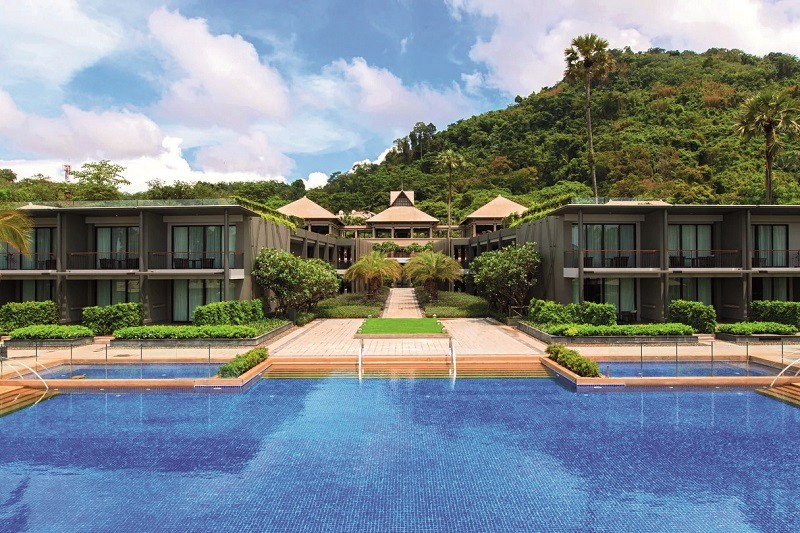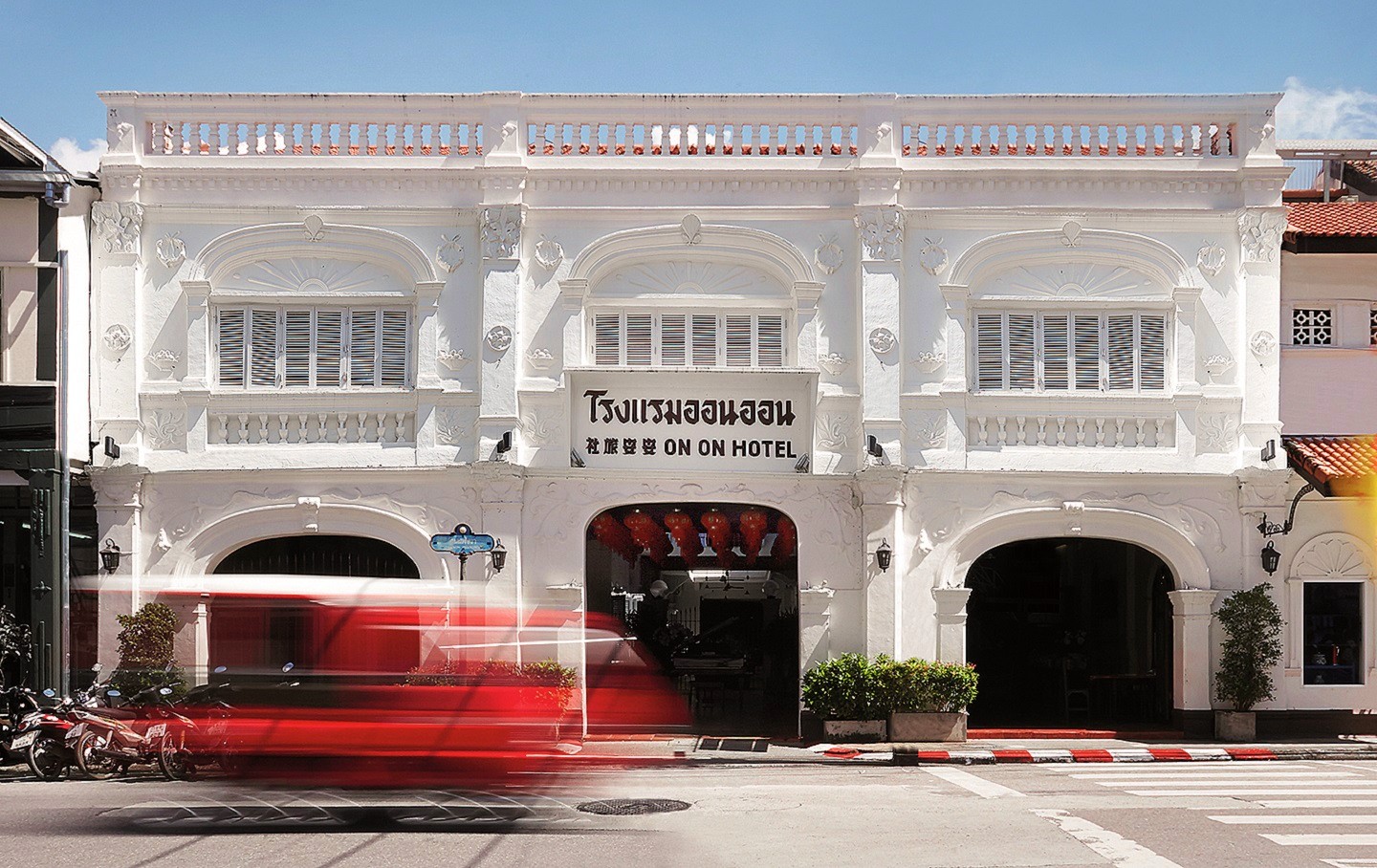
The Memory at On On Hotel was the filming location for The Beach, starring Leonardo DiCaprio (Photo: On On Hotel)
A family’s values cohere by passing on histories and treasured keepsakes, giving meaning to the English word “heirloom”. Its etymology perpetuates an age-old expectation that any endowment will include a practical tool, echoing the root word “loom”. But, for many Chinese communities in Phuket, Thailand — whose ancestors travelled to the island during the tin-mining boom in the 1900s and set up homes — protecting their heritage has turned into a lifelong pursuit of cultural preservation.
“It is a national duty, especially when your forefathers used to serve King Rama VI,” says Chanachon Tandavanitj, fifth-generation owner of the Chinpracha House and Museum, as he takes us on a tour around the 119-year-old mansion built by his great-great-grandfather Phra Phitak Chinpracha.
Son of wealthy Chinese businessman Luang Bamrung Chin Prathet from Fujian, China, Phra Phitak earned the Tandavanitj family name in 1916 from the royals after serving as a member of the paramilitary troopers called Wild Tiger Corps. He was only in his 20s when he built his first home, using furniture from China, fences from the Netherlands and tiles from Italy. Phra Phitak treated details as no less essential than form and structure — his penchant for the Peranakan culture and design in Penang, where he studied as a young boy, was reflected in the ornate embellishments framing the doors and stairway.
chinpracha_house_and_museum2.jpg
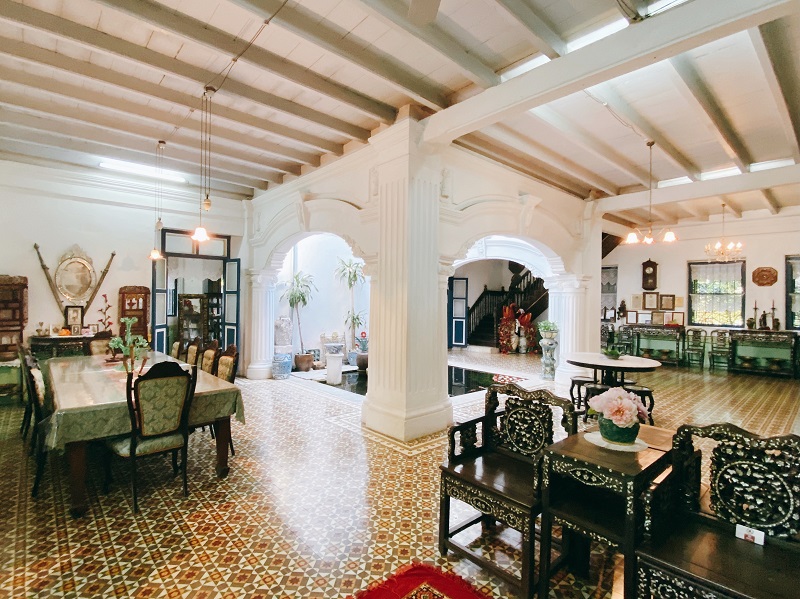
Though slightly weathered, this Sino-Portuguese structure referred to by the locals as ang moh lounge still meticulously retains relics of a bygone era, such as the bride-and-groom chamber, kitchen with charcoal irons, century-old earthenware and conventional mining tools. Carriers of tradition, whether in the form of intricate manik (beaded) shoes or the decorated covered pots kam cheng, have been preserved as they were in this home, which was the filming location of the 1993 war drama Heaven & Earth and venue of many a Thai wedding in modern times.
Old houses tell you whose footsteps you are following in, and maybe even give you roots. “This is a window into history no textbook could rival,” says Chanachon, fondly known as Mr Tan, as he stares deeply into the koi pond anchoring the living room. “I can only hope my children will pay these stories forward, except they will no longer belong to me, but to them and those who listen.”
chinpracha_house_and_museum_koi_pond.jpg

The restored Chinpracha House and Museum will no doubt continue to be a place of pilgrimage for historians, architects and artists for decades to come, but not all poetic homes built on stones and stories on the island survived gentrification. In fact, many are giving way to the sweeping threat of vertical urbanism, leaving very few signs behind by which to study the past. So, before these dwellings vanish, see the evidence of these early Chinese settlers or lose yourself in the narrow pathways lined by clan houses, temples and pre-war settlements. With a little digging and prying, keen explorers can discover far more about Phuket than its requisite sandy beaches and shrines.
Tuk of the town
The varied faces of Phuket, both archaic and contemporary, are part of a magnetism that debunks its reputation as a perennial party town. In this beguiling mosaic of overlapping cultural identities distilled from sediments of many of the world’s civilisations, the island’s lode of heritage compels you to slow down to really experience it. Just like the Chinpracha House and Museum, tasteful reincarnations of old mansions are putting the brakes on haphazard development.
For instance, the turquoise-blue Kanok Kwa House, better known by its cooler moniker Endless Summer, on Yaowarat Road was converted into a boutique-cum-coffee shop by French entrepreneur and former makeup artist Stéphanie Simoncini. The fashion treasure trove teeming with second-hand steals caters for the free-spirited who worship at the altar of all things boho-chic — plan your next wardrobe update around patchwork and paisley over coffee and crêpes.
endless_summer_more.jpeg
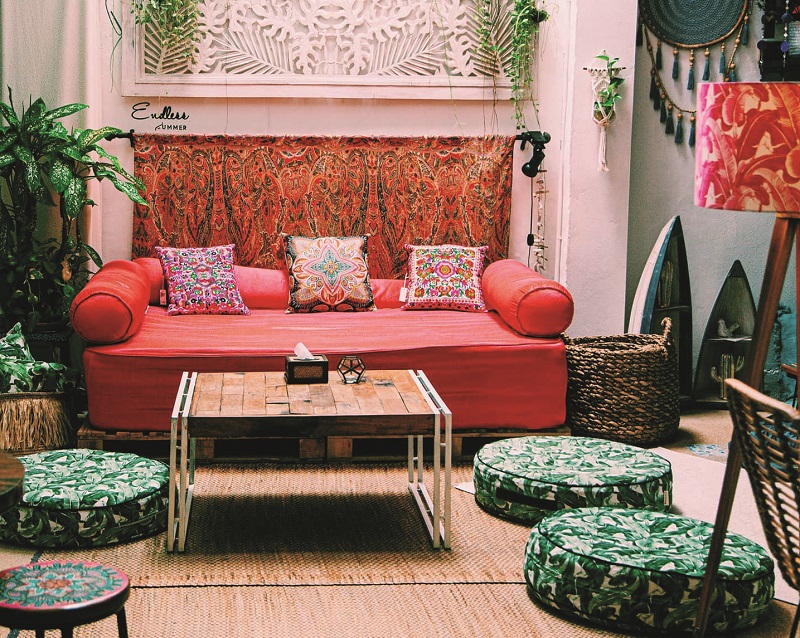
This archetypal vacation island has iconic landmarks that do not necessarily reach for the sky. More Sino-Portuguese influence abounds on Phangnga Road, where colourful and patterned tiles — seen on pavements as well as sidewalks — gain more footing in local architecture. Those who have been keeping their eyes and ears on the ground may find their way to The Memory at On On Hotel, a boutique gem that appeared in the film adaptation of Alex Garland’s cult novel, The Beach, made famous (or infamous, if you much prefer his 1996 book about Gen-X vagabonds in search of a tropical Eden) by Leonardo DiCaprio. Designed by Penang craftsmen in 1929, On On is showing its age, and that plays to its advantage. The lobby, illuminated by a stream of red lanterns hanging overhead, is a living museum that woos history buffs while the sun-soaked courtyard surrounded by verandas and retro window shutters lures lazy guests out of their cosy poster beds. In a place where the staff are more cheery than the curtains, the hotel, though lacking in cutting-edge amenities, more than makes up for it in hospitality.
on_on_hotel_3.jpeg
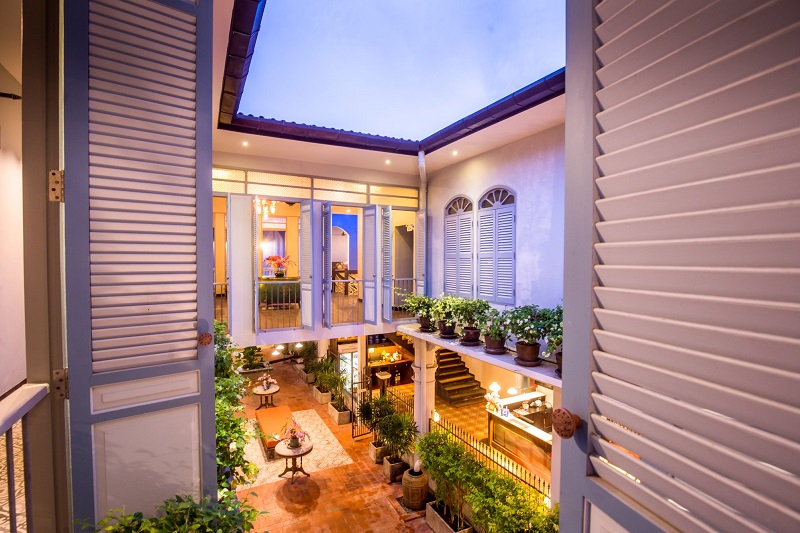
If a building’s façade communicates its sense of style to the world, the refurbished Kasikornbank just across the road from On On is unabashed about its opulence. The clashing design elements between lattice, decorative ironworks, glass and the existing brick structure could easily get lost in translation, especially when old and new were expected to coalesce in a thoughtful manner. But the message sent out by this marbly white edifice, which has served the community for 77 years, is resoundingly clear: Conservation does not need to rely on specious novelty to create functional spaces with mission and meaning. Shutterbugs, miss this visual marvel at your own peril.
One of the delights of travel is coming upon a hidden eatery or a lively street that sums up the spirit of a nation. Former red light district Soi Romanee, hemmed in by colourful pre-war buildings not unlike those found in Penang and Melaka, comes to mind, but locals know better to point you in the opposite direction. Bastion of poetry and offbeat out-of-prints South Wind Books may thrive under the radar but many in-the-know bibliophiles have benefited from recommendations by the owner with specialist knowledge. Located just next to the Shrine of the Serene Light, the second-hand shop tries to flatter every taste by stocking titles in various languages such as German, Finnish, Swedish and French, while keeping its rarities on open shelves so they can gain a new home.
bang_rong.jpg
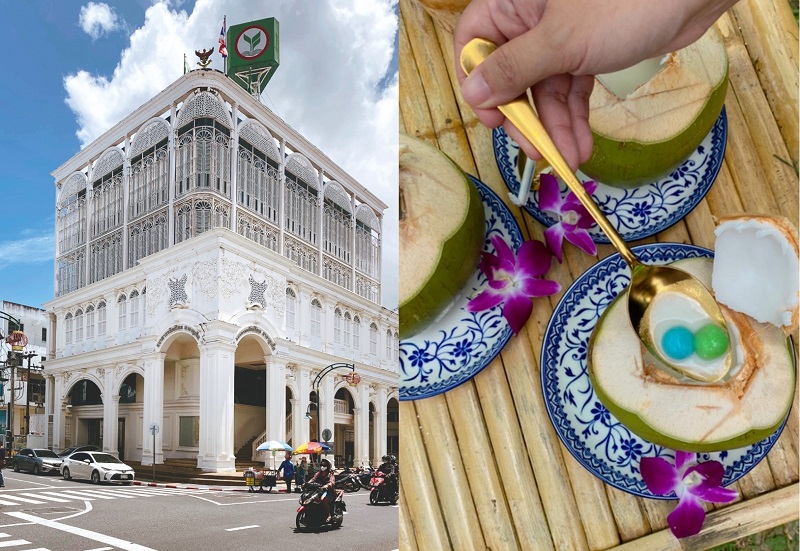
Wish to explore overlooked serenity that is not clogged with traffic? Go green. Pinpointing and participating in all of Mother Nature’s greatest hits on the island could take weeks, but if you have time for only a few, community-based tourism social enterprise Bangrong Connect can curate an itinerary that includes highlights such as coconut-picking, a mangrove forest cruise in a long-tail boat and a sustainability programme that involves releasing berried female crab back into the sea. Although most of these activities require you to venture slightly out of town, every experience you partake of will give back to the fishermen and farmers of the Bang Rong Muslim community with a history that dates back more than two decades.
Off the eaten path
When dining out in Thailand, the spectre of crippling indecision lurks around every corner. Once you overcome the enduring dilemma of where to eat, you are still faced with the predicament of what to order. The answer is quite straightforward at Raya: kaeng poo kana jeen, or rice noodles with crab curry. Certain foods promise solace as much as they fuel, and this comforting orchestration of creamy and spicy is the perfect vehicle for lapping up whatever is on your plate after the silky vermicelli has long been devoured. Heat is usually attenuated for Western palates but there will be no concession in this Bib Gourmand-appraised restaurant housed in a 130-year-old mansion.
curry.jpg

The surest way to a memorable dining experience is to trawl the sidewalks, and Phuket is never short of nooks that make living and eating a perpetual revelation. Tukabkhao, a villa-like eatery with a giant lobster replica perched on the building’s exterior, is worth shelling out for. A seafood haunt this is not, though. Nothing quite matches in this Thai institution adorned with frilly tablecloths, oriental porcelains and English chandeliers, yet everything jives. We reckon the lynchpin, which every customer can agree on, is the food. As your fingers, slicked in gravy, work through the spread, flavours and textures multiply in curries gentle or ferocious, in porky dishes fried or stewed. Riotously aromatic, a spoonful of prawn tom yam or stir-fry melinjo leaves with shredded egg reveals why this place does not require advertising.
A good cuppa is a social lubricant but Bookhemian, a java haven on Thalang Road that doubles as a cinematheque and bookstore, moves conversations as well as the town’s cultural plot forward. Doling out crafted tipples named after classics such as A Clockwork Orange and Yellow Submarine, Bookhemian presents a novel way to enjoy literature and music through the lens of a shot glass. In this shop, which has the art of the written word infused into everything from the elaborate menu to the vintage décor, a drinking session is the closest thing to sharing a meal with some of your favourite literary characters.
tu_kab_khao_food.jpg
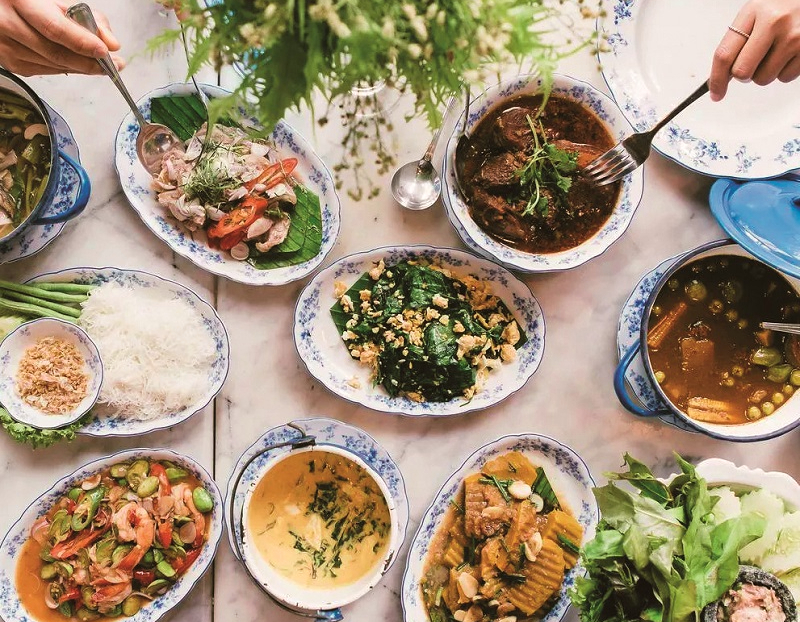
If you have a soft spot for a stiff drink, the island has a burgeoning number of smartened-up bars and speakeasies that could rival any feted establishment in London or Bali. Snaking alleyways lend themselves to mystery, and today’s best watering holes for raising a glass are fittingly clandestine. Once you get past the wall of bookshelves at The Library, the rogue entrance opens up to a raucous view of bartenders juggling glow-in-the-dark bottles and flipping cocktail shakers with a magician’s sleight of hand. Theatrics are not limited to the mixology acrobats behind the counter — drinks come in wild card concoctions such as the Three Kingdom (tequila, vanilla, oolong tea, lime, apple and passion fruit); Little Witch & Magic Lamp (gin, apple, cinnamon, cucumber, lime and egg white) and a festive nightcap fit for any celebratory occasion, Street Art (rum, jasmine, butterscotch, palm sugar and egg white).
the_library_bar_4.jpeg

When darkness engulfs the sky, and the action continues behind closed doors, you are most likely to have the streets to yourself soon after dinner. Inhabitants of this “Pearl of the South” return to their nests, eager to greet discerning travellers in search of an unfiltered and uncommercial dose of distinctive Phuket the next day.
Beach, please
A Marriott establishment is making waves at Nai Yang
Most hotels are so perfectly manicured that they lack character, but Phuket Marriott Resort and Spa, Nai Yang Beach is imbued with the kind of hospitality that makes you want to know its surroundings intimately. Even more alluring is a stay that is a few (barefoot) steps away from one of the island’s prettiest beaches.
The resort’s envious location, just 10 minutes from the Phuket International Airport, means you do not have to brave the traffic downtown for a good rest. As tourism accelerates at a steady clip with more hotels on the rise, this Nai Yang stronghold edges out its competition with well-appointed beachfront rooms and lofty villas overlooking a private garden. The hardest decision is whether to spend time by the 400m pool or check yourself into a restorative spa for an anti-ageing facial or tension-busting massage.
Sunset dinners by the beach often conjure up an image that food is beside the point, but you would be wrong — much of the menu focuses on seafood freshly harvested from the sea, with a subspecialty in grilled meats and pastas. There is the ever-reliable Andaman Kitchen, too, which tempts patrons into its inviting terrace for a meal of Thai delights and globally inspired cuisine.
More information here.
This article first appeared on Oct 31, 2022 in The Edge Malaysia.

